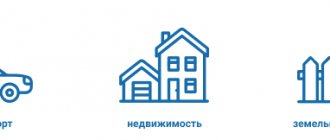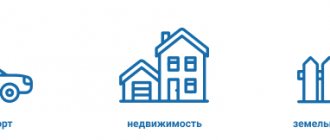- Procedure and terms for payment of property tax by individuals
- Property tax rates in Sochi
- Tax calculation procedure
- Calculation example
- Property tax benefits in Sochi
The procedure, rates and deadlines for paying property tax in the city of Sochi, Krasnodar Territory for 2021-2018 are established by the decision of the City Assembly of Sochi dated October 26, 2016 N 150 “On the establishment of property tax for individuals in the territory of the city of Sochi” (as amended, effective in 2021).
How is personal property tax calculated for 2021: basic principles
Indeed, the property tax of Russian citizens is calculated by default by inspectors of the Federal Tax Service, and notifications containing the amount to be transferred to the budget are sent to the addresses of property owners.
But it is always useful for the taxpayer to verify the correctness of the calculations presented by the tax authorities. Since 2015, this tax has been calculated on the basis of the cadastral price of the property (if it is established in the territory where the property is located), while previously it was calculated based on another indicator - inventory value. The fundamental difference between the cadastral price and the inventory value is the proximity of the former to market prices for real estate. The more expensive the housing, the more tax is now paid to the budget for it.
The objects of taxation in this case may be (Article 401 of the Tax Code of the Russian Federation):
- residential buildings (including country houses);
- apartments;
- rooms;
- garages;
- parking spaces;
- buildings under construction;
- other types of real estate owned by citizens.
When calculating tax for 2021, the following indicators are used:
- cadastral price of real estate (calculated by the Federal Cadastre Service, Cadastral Chamber, after which the data is transferred to Rosreestr);
- rates established for the cadastral price (their value is determined by municipal authorities taking into account the norms of Article 406 of the Tax Code of the Russian Federation);
- deflator coefficient (determined by the Ministry of Economic Development of the Russian Federation);
- deductible area of the apartment to reduce the tax base, or deduction (also determined by municipal authorities taking into account the norms of Article 403 of the Tax Code of the Russian Federation);
- benefits (established by Article 407 of the Tax Code of the Russian Federation);
- reduction coefficients (taken into account during the first three years from the beginning of application of the tax calculation procedure based on the cadastral value).
As of January 1, 2020, property tax for individuals is no longer calculated based on inventory value (Law “On Amendments” dated October 4, 2014 No. 284-FZ).
If you have access to ConsultantPlus, check whether the tax authorities calculated your property tax from the cadastral value correctly. If you don't have access, get trial of online legal access.
Let's study in more detail how to use all these indicators in practice.
Formula for calculating property tax for individuals
In order to calculate the payment of the Tax Code of the Russian Federation, a formula has been established that has the following form:
H = (H1 – H2) × K + H2,
where: N is the amount of tax payable;
N1 - the nominal amount of tax, determined taking into account only the cadastral price of the object, the rate established for it and the deduction;
N2 - the nominal value of the tax, calculated taking into account only the inventory value of the apartment, the rate, as well as the deflator coefficient and has 2 definition options:
- As the amount calculated to be paid for this object for the last year of using the procedure for calculating the base from the inventory value. It can be applied both from the calculation for 2015 (and then will coincide with option 2 of the N2 calculation), and from later years, depending on the year from which the subject of the Russian Federation fulfilled all the conditions for calculating tax on the cadastral value provided for in paragraph 1 tbsp. 402 of the Tax Code of the Russian Federation.
- As the amount of tax calculated for 2014 in accordance with the procedure established by the expired Law of the Russian Federation “On taxes on property of individuals” dated December 9, 1991 No. 2003-I. This calculation is applicable for calculating tax on cadastral value starting from 2015.
K is a reduction factor, consistently increasing by 0.2 annually during the first 3 years of the beginning of the application of the calculation from the cadastral value, thus amounting to from 0.2 (in 1 year) to 0.6 (in 3 year). Starting from the 4th year, the reduction factor does not participate in tax calculations.
When calculating the tax for 2021, reducing coefficients were used (see Information from the Federal Tax Service dated September 23, 2021): 0.2 - for 10 regions (Altai Republic, Crimea, Altai and Primorsky Territories, Volgograd, Irkutsk, Kurgan, Sverdlovsk, Tomsk regions, Chukotka Autonomous Okrug), where from 2021 the cadastral value is used as the tax base for the first year; 0.4 – for four regions (Republics of Dagestan and North Ossetia - Alania, Krasnoyarsk Territory, Smolensk Region), where the cadastral value is used as the tax base for the second year; 0.6 – for seven regions (Perm region, Kaluga, Lipetsk, Rostov, Saratov, Tyumen, Ulyanovsk regions), where the cadastral value is used as the tax base for the third year.
Let's look at an example. Let's agree that:
- we pay tax for 2021 from the cadastral value;
- the tax is calculated from the cadastral value starting from 2018;
- we live in the Lipetsk region;
- We do not have tax benefits under Art. 407 Tax Code of the Russian Federation;
- we have an apartment of 70 sq. m, its cadastral value is 3,000,000 rubles, and its inventory value is 300,000 rubles.
The tax rate for the cadastral price of property established in the city is 0.1% for objects with a value below 10 million rubles.
For inventory value, the rate that is established at the federal level is used, due to the absence of a regulating municipal regulatory legal act. It is 0.1% if the property, taking into account the deflator, costs less than RUB 500,000. (Subclause 2, Clause 6, Article 406 of the Tax Code of the Russian Federation).
The deflator established for 2021 (the last year of application of the calculation from inventory value) is 1.425 (Order of the Ministry of Economic Development of Russia dated November 3, 2016 No. 698).
Property tax deduction for apartments - 20 sq. m. The one established at the federal level is used, due to the lack of a regulating municipal normative legal act (clauses 3, 7 of Article 403 of the Tax Code of the Russian Federation).
The reduction factor for 2021 is 0.6 (clause 8 of Article 408 of the Tax Code of the Russian Federation).
To calculate the H1 indicator:
1. We determine the value of the cadastral tax base, taking into account the deduction (all calculated data are rounded to the nearest ruble).
In accordance with paragraph 3 of Art. 403 of the Tax Code of the Russian Federation, it is equal to the cadastral value reduced by the cadastral value of 20 square meters. m of living space. Thus, we:
- Find the cost of 1 sq. m of living space: 3,000,000 / 70 sq. m = 42,857 rub.
- Based on the cadastral value of 1 sq. m, calculate the cost of 20 sq. m of living space: RUB 857,140.
- We subtract from the full cadastral value of housing (3,000,000 rubles) the resulting figure (857,140 rubles):
3,000,000 – 857,140 = 2,142,860 rubles.
2. We multiply this amount by the rate determined for the cadastral value (0.1%). The value of H1 will be 2,143 rubles.
Indicator N2 is equal to the amount of property tax calculated for 2017 based on inventory value:
1. We have a tax base of 300,000 rubles.
2. Multiply it by the deflator coefficient (1.425) and get 427,500 rubles.
This means that we can apply a rate of 0.1% when determining the H2 tax (Article 406 of the Tax Code of the Russian Federation). Multiplying the inventory tax base by this rate, we obtain the H2 indicator equal to 428 rubles.
Subtract indicator H2 from H1:
2,143 – 428 = 1,715 rubles.
We multiply the result by 0.6 (reducing factor for the third year of tax calculation from the cadastral value in accordance with Article 408 of the Tax Code of the Russian Federation), we get 1,029 rubles. We add the H2 indicator to it - and we get 1,457 rubles. This is the H indicator, that is, the tax that must be paid to the budget.
If it turns out that H1 is less than H2, a tax must be paid to the budget, which is equal to the H1 indicator (clause 9 of Article 408 of the Tax Code of the Russian Federation).
If a subject of the Russian Federation did not decide to charge tax on the cadastral value and did not approve this value at the beginning of 2016 (i.e., did not fulfill the conditions provided for in paragraph 1 of Article 402 of the Tax Code of the Russian Federation), it can begin to apply such a calculation from the beginning any year, from 2017 to 2021, and then the calculation of the H2 indicator will be made based on the inventory value multiplied by the deflator coefficient established for the last year of application of the tax calculation from the inventory value and the tax rate.
What to do if the Federal Tax Service employees calculated the tax payable incorrectly? Find out the answer to this question by getting trial access to the ConsultantPlus system for free.
You can check the correctness of property tax calculations using the calculator located on the website of the Federal Tax Service of the Russian Federation.
How much will the apartments cost after changing their status?
Especially for Rossiyskaya Gazeta, Pavel Logachev, commercial director, told what awaits the market and housing prices in the event of a positive decision regarding a change in their status and briefly discussed the main differences between apartments and apartments:
— Apartments have the formal status of non-residential premises, which means, at a minimum, the inability to register and increased taxes, the rate of which can vary from 0.5% to 2% of the cadastral value of the property (in the case of apartments, the tax rate ranges from 0.1% to 0.3%), increased utility costs. The apartment owner must be prepared for the fact that the project may not be provided with social infrastructure, since at the legislative level the developer is not obliged to build it for such real estate.
However, there are pleasant nuances. In the apartments you can get temporary registration for 5 years with the possibility of extension, although only if the house has hotel status. But increased tariffs for housing and communal services are often offset by the difference in price when purchasing them. If we compare an apartment and an apartment with the same characteristics, the first will be 10-15% cheaper in a new business class building, the difference in price in the comfort class reaches 15-20%. You can buy apartments with a mortgage, register ownership of them, pledge them, donate them, or rent them out.
Interest in this format on the part of buyers is high - the share of apartments in the structure of demand has reached 8-10%. Particular attention is paid to lots with finishing. From 2021 to 2021, their share in Moscow increased from 60% to 90%, with the most active jump observed in mixed-type properties, where both apartments with and without finishing are offered. As a result, the share of transactions for furnished apartments at the end of six months of 2021 amounted to about 40%.
Most likely, apartments cannot be fully equated with housing, because the goal of the new law is to eliminate the gap in legislation and give legal status to non-residential premises built over the years (with the exception of hotel-type apartments), where people actually live. Let me remind you that the concept of “apartments” has not yet been defined in any law. According to their legal status, they are in the same status as commercial real estate; accordingly, they are not subject to the norms of housing legislation. In addition, owners cannot complain about noise from neighbors and are not immune from the appearance of an office behind the wall.
Even in the event of a negative decision on assigning a new status to non-residential premises within a residential complex, the maximum risks for the owner will be more expensive maintenance of the premises and increased tax rates. With one caveat - the house must be built or reconstructed without violating current legislation and building codes.
In my opinion, the following scenarios can be expected in September: a subtype of residential premises will appear in the legislation - apartments; the tax rate will be reduced from 1.5-2% to 0.5% (as it is now for hotels); owners of such real estate will be able to obtain registration.
As for the cost of apartments, if the law is adopted and they are given the status of residential premises, the price of such premises in comfort and business class houses may increase by 10-15%. In the elite class we do not expect a significant difference in price. As a rule, the priorities of potential buyers of such housing are location, quality of the project, and image component.
However, there will be a number of issues that still need to be resolved. Among them: the cost of utilities, the possibility of obtaining a resident parking permit and others. There are nuances that must be taken into account so that non-residential premises can be classified as residential and included in the list of real estate with preferential taxation. First of all, this area must be used exclusively for residential purposes.
To qualify for preferential taxation, legal entities must not be registered in the apartments, and the premises themselves cannot be used for business activities or be leased.
As for redevelopment objects, they often do not meet any standards related to residential premises. So-called loft-style apartments can be located in former industrial buildings and cannot be considered suitable for housing for a number of reasons. Such apartments may remain in the status of non-residential premises.
Results
Since 2015, property tax for citizens of the Russian Federation has been calculated taking into account the cadastral price of the property, if all the conditions for this have been met in the corresponding region of the Russian Federation (a law has been adopted and the cadastral value has been approved on an object-by-object basis). In order to mitigate the increase in the tax burden on payers, the formula for calculating tax for 2015–2020 takes into account indicators such as inventory value, rates on it, and a deflator coefficient. Further, the tax will be calculated without using indicators that reduce the amount of tax.
You can familiarize yourself with other nuances of paying property tax in this article .
You can apply for a property tax benefit or report privileged property at any tax office. Read more about this here.
Sources: Tax Code of the Russian Federation
You can find more complete information on the topic in ConsultantPlus. Free trial access to the system for 2 days.
What is stated in the documents?
This question is key!
When purchasing an apartment, you should carefully study all the documentation provided by the developer. The most important thing is the purpose of the building in which the apartments are located. The minimum tax rate for apartments is 0.5%, but only if several conditions are met simultaneously:
- they are not located in a shopping, office or business center;
- cadastral value of apartments is below 300,000,000 rubles;
- Neither the technical documentation nor the Rosreestr database (order an extract from the Unified State Register and check, you can get it here within a few minutes) does not indicate the purpose for offices, retail space or other commercial use. If this is stated, get ready for a higher tax rate.
The best use of the building is as a hotel. The tax rate for apartments in this situation will be 0.5% of the cadastral value.
What tax should I pay if the cadastral value is above 300,000,000 rubles, or the documents indicate the use for offices, as well as if the location is in a business or office center? In this case, the property tax for individual apartments will be 2%.
For owners of large apartments, not everything is clear. Many regions provide a flexible tax system for luxury real estate.
Here, for example, is how it works in Moscow:
- If their area does not exceed 300 sq. m, then the first 150 m2 is proposed to be taxed at a preferential rate of 0.5%;
- And the remaining m2 - at a rate of 2%.
Example : if you own an apartment of 250 m2, then you pay 0.5% of the cadastral value for the first 150 m2 and 2% of the cadastral value for the remaining 100 m2.
Despite the high tax on apartments, there are advantages to consider. Currently, apartments are no longer considered scarce real estate, and many developers have reduced their prices.
On the other side. Although the tax for apartments has been increased excessively, in large cities such property can be purchased much cheaper than an apartment. The difference of 1 - 2,000,000 rubles will compensate for the payment of property taxes for the next 100 years.








